5 deadly mushrooms that are common in the forest
If you are interested in collecting mushrooms for food, there are hundreds fungi that produces edible mushrooms that has a vast variety of flavor, and is a good ingredient for lots of different dishes. However, in this blog post I will focus on some of the most deadly mushrooms that you can find in the forest.
Before starting, I just want to clear up a common misconception. Most mushrooms are not actually poisonous. Most are in fact not, but a lot of people are afraid to pick any mushroom because of the poisonous ones. That is a good rule, but getting to know the poisonous mushrooms are really not that hard, and in my country there are about 10-15 mushrooms you need to learn to stay away from. The rest are mostly non-edible, but not poisonous. So if you are interested in picking mushrooms, learn the ones that you need to stay away from, and a few good beginner mushrooms, and you can gradually expand the number of known mushrooms until you are comfortable with picking most of them.
Also note that this blog does not contain all deadly or dangerous mushrooms, and you should always get your information on this from a local source. The fungi of Asia is vastly different from that in Europe or America, so get to know your local mushrooms before picking.
Anyway, on to the list of 5 deadly, but common mushrooms!
5) Deadly webcap (Cortinarius rubellus)
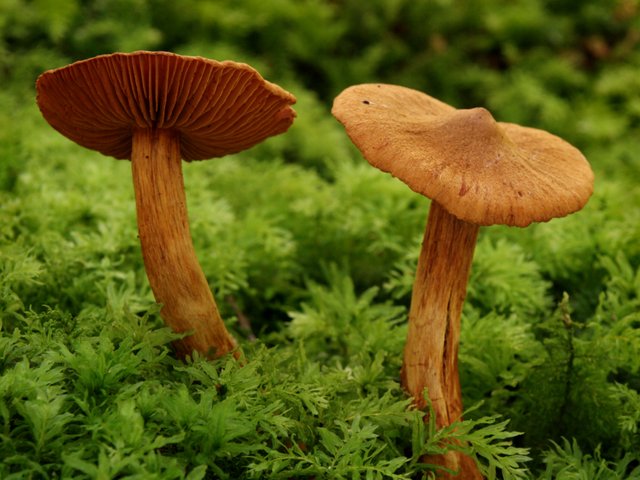
This is an extremely dangerous mushroom, and here in Norway I find this everywhere during the late summer. It is extremely common, and a single mushroom is enough to kill a human.
The poison will not actually kill you right away, death is actually coming for the consumers up to 4 weeks after eating it! This almost sounds like a weapon from a novel or movie, but it is true. The deadly component is orellanine, and there is no known antidote, so the only "cure" is dialysis and eventually a kidney transplant. The symptoms you get in the first few weeks are very mild and most people think its just a cold, but you will gradually get worse until your liver shuts down.
If you are picking mushrooms, learn to spot this one! I guarantee that you will find hundreds of it in conifer forests.
4) False Morel (Gyromitra esculenta)
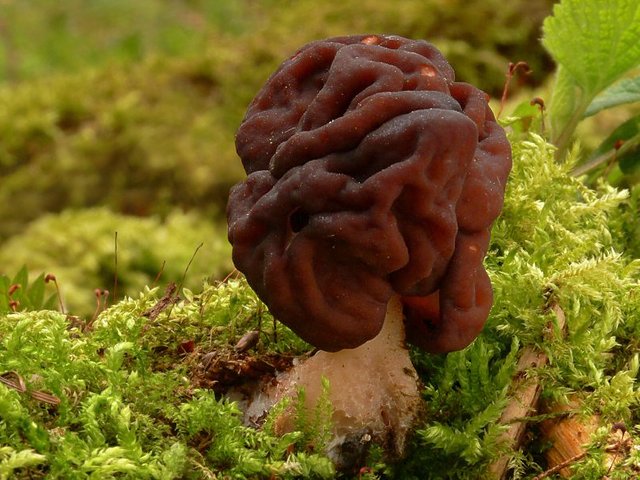
The False Morel almost looks like a human brain, so use your brain to remember to stay away from it. This mushroom is deadly if eaten raw, and even is cooked improperly. However, it's considered a delicacy if cooked right, but make sure you know what you are doing before attempting this. Most people stay away from this and most Morels due to the fact that a lot of people are having problem separating this from the edible morels. This mushroom is not as common as the other ones on the list, but some areas have lots of them.
Inside the False Morel you will find a toxin called gyromitrin, which will be turned into monomethylhydrazine after being eaten. This will affect the liver and the nervous system, and if you eat enough you will become dizzy, get a headache, and eventually fall into a coma which you might not wake up from.
This mushroom is found in both Europe and North America, so learn how to spot and stay away from this one.
Just a quick edit, because some people brought it up. Some people forage and eat this mushroom without any problems, and while most mushrooms won't kill you, the right one might. The levels of the gyromitrin in the mushroom seem to vary a lot in each individual, so the mushroom you eat might be perfectly safe, or deadly, all depending on the toxin levels. I have always been taught that you should stay away from this mushroom at all costs, but it would seem that some people disagree, and that is of course fine. However, be aware that this mushroom can potentially kill you if you eat it improperly cooked!
3) Destroying Angels (Amanita virosa / Amanita ocreata)
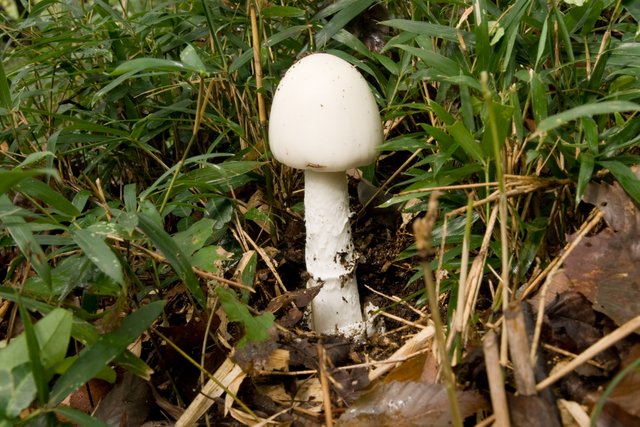
These mushrooms from the Amanita genus is closely related to the Fly Amanita, which is not all that poisonous, but the Destroying Angels are! The Amanita virosa is the European version of the mushroom, while A. ocreata is the North-American version, and both are equally deadly. Don't ever try to consume any of these, and never pick and any Amanita species unless you are 100 % certain that you know that it is edible.
The are actually several deaths from these mushrooms every single year, mostly from people thinking its a Agaricus species, which has a lot of edible mushrooms in its genus.
These mushrooms are very common in the summertime here in Norway, and I'm sure you will find it easily in a lot of other countries as well. Make sure you don't pick up this one, and throw away all the mushroom in your mushroom net or basket if you for some reason mix one of these in the bag.
The toxin in the Destroying Angels are amatoxin, which affects the liver. Within the first 24 hours of consuming this you will get delirium, vomit, diarrhea, cramps and lots of pain, but it is usually too late to save the liver once you start noticing the symptoms. If you are lucky you might be able to get a liver transplant before you end up getting killed by the toxins.
2) Galerina marginata
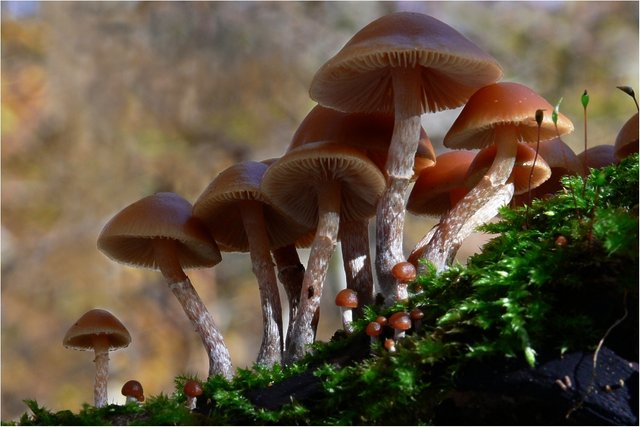
This is another deadly mushroom I find a lot when I'm outside. It grows directly on dead wood such as logs, and are found in pretty much all of the world. The problem with this deadly mushroom is that it looks a lot like some other, edible mushrooms, so a lot of people mix up these ones with edible species.
The toxin here is once again amatoxin, the same as from the Destroying Angels, so get over to the hospital as soon as possible if you consume this!
1) Death Cap (Amanita phalloides)
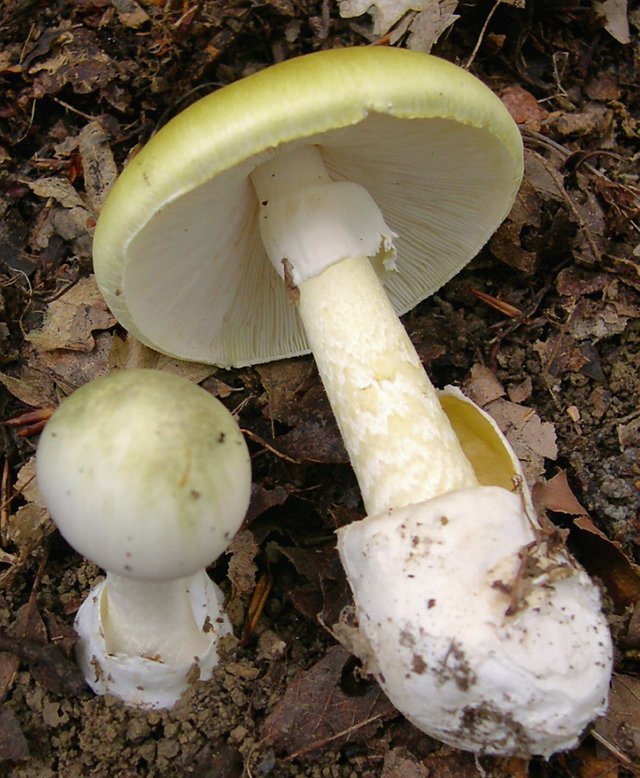
A final Amanita species, and this is the most dangerous and deadly of them all. This mushroom is responsible for most of the human deaths from mushroom poisoning, and yet again amatoxin is the responsible toxin.
The cap on this mushroom can be greenish, yellowish or white, and it might have the padded dots you usually associate with the Fly Amanita. The phonology can be pretty changing, with one individual looking a lot different from other individuals, so accidentally picking this or the Destroying Angels is pretty common.
This species is luckily only found in Europe, so you Americans don't need to worry about this one.
Sources
A lot of it is based on knowledge I have from picking mushrooms, but all facts were checked on Wikipedia to make sure I didn't remember anything incorrect.
Thanks for reading!
This is my first proper post on Steemit, so please give me some feedback, and I will make sure to have all positive and negative feedback in mind when I make my next post.
I intend to make more nature related posts in the future, so make sure to follow me if you like these sorts of posts.
All images are used with the Creative Commons license from Wikimedia Commons.
We eat a mushroom on the second photo!
https://steemit.com/nature/@yetaras/the-first-spring-mushrooms
Oh, that is cool! Thanks for linking to your post about it, it was interesting. I think it's really interesting that some mushrooms are considered edible in some places and dangerous in others. As for the Gyromitra esculenta / strochok, there are studies that show that it can be poisonous, especially if eaten raw. I was always taught to stay away from this mushroom, and never pick it.
Do you eat a lot of it when you harvest it, or just a few mushrooms per year?
This is not only a great first post, it's a really great post in general. I love that you picked to share the poison/potentially dangerous mushrooms--it was a fun read and love that you shared some of your Norway experience. I found you through @foraging-trail. Upvoting and following you.
Thanks for the positive feedback! I'm glad that you found the post enjoyable, and hope you learned something new while reading it!
Upvoted by @foraging-trail
Thank you for following and upvoting @foraging-trail
You can find out more about the Steemit Foraging community and guidelines for being upvoted by the @foraging-trail here and here.
Nice article. Upvoted!
Thank you!
Thank you for sharing this :)
No problem. I'm always happy to be able to share information about the things I'm passionate about.
This is awesome. I am a beginner in the field of mushroom picking :) I follow you to get to know more :)
Thanks for sharing!! I picked up mushrooms in Polish forests since I was little and I seen some of the ones above around :D
You're welcome :)
Which mushrooms do you usually forage in Poland?
This year there was nearly non :( but I was ale to pick some called Imleria badia. I might make a post about eatable mushrooms around my area.
Good article mate.
The first mushroom on the list looks exactly like one I used to collect a lot here in central Europe which is the most edible and common one here.
So I think I should not go out and pick mushrooms on my own :D.
So I am guessing you are Norvegian. I was wondering lately if there are any mushrooms during Winter or pre-Winter. Any experience in Norway or Sweden with such mushrooms?
Thanks!
You should be very careful with anything that looks like the first one on the list. There are extremely many species in the Cortinarius genus, and many of them look very much alike, but this genus has some of the most dangerous mushrooms int he world, so it's better to be safe than sorry. Here in Norway the general consensus among mycologists is to stay away from any Cortinarius mushroom with the exception of Cortinarius caperatus (which looks very different from Deadly Webcap). Anyway, do you know the name of the one you collect? I'm interested in reading about it, because as I've said, we don't really pick anything that looks like the Deadly Webcap over here.
Picking mushrooms on your own does not really have to be dangerous at all, but as I said in the blog post, you should start with some of the easier mushrooms. Starting out with easy ones such as Boletus edulis or Cantharellus cibarius (chanterelle), because they are pretty much impossible to mix with anything dangerous.
It's a bit too late to pick edible mushrooms at this time of the year. I found some a few weeks back, but once the ground freezes, most fungi don't produce mushrooms. As a general rule we usually say that the mushroom season ends around November 1st.
That's a nice first proper post, then! I especially like hearing about your own experience there in Norway. If you have any of your own photos, I'd enjoy seeing those. And how you are using any of the mushrooms you find! I curate for the @foraging-trail, where the priority is on sharing authentic experience and perspectives.
My own approach is to eat only the ones that I can identify with certainty. Even the toxic mushrooms, though, are OK to pick and look at. Simply touching them or taking them home to ID with books is not dangerous. Just don't leave them where pets or little kids can get at them. I've been looking at the North American Mycological Society's annual reports of mushroom poisoning incidents. I was really surprised to learn how many dogs get poisoned by mushrooms -- I guess some dogs eat anything they can get in their mouth and really can't tell a good mushroom from a bad one.
Enjoy all your fungi -- in an appropriate way, lol, whether they are tasty or toxic! : )
Thank you!
I usually try to bring my camera along when I'm in the forest for more than a few hours at a time, but I'm not really a good photographer, so the pictures become more blurry than I would like them to be. I hope I find the time to learn a little bit more about how to properly operate my camera before the season begins again next year.
When I collect mushrooms I usually dry them and store them in an airtight container until I want to use them.
I agree that it's best to only eat the ones you are 100 % certain you can identify. I've thrown away lots of 95 % certain ones myself, just because the extra mushrooms are not really worth the risk. You only have one life, but lots of opportunities to find new mushrooms!
What you are writing about dogs are interesting. Do you know if dogs are generally more likely to get sick from mushrooms than humans? I know that some of the mushrooms we consume have a small amount of toxins in them, but are harmless to humans unless you consume them every day, but pets and children might have a lower tolerance for these toxins I suppose.
I checked out the foraging-trail account you curate. To be honest I don't completely understand all of Steemit yet, so I'm not completely sure what it means to curate an account, but I'll make sure to use the foraging tab when I write about foraging mushrooms in the future :)
I've been drying some mushrooms myself this fall - which means that my harvests have been more than I can eat at one time. Yay!
I don't know whether dogs are more likely than people to get sick. It does take a person to report the dog's problem, though, obviously. And certainly, dogs have different sensitivities than people, to many things, like chocolate and salmon. And with all the recent work on mushrooms genetics, it's clear that mushroom chemistry can vary more than was imagined - and would explain why some people get sick from a particular mushroom and other people, eating the same species but from a different place, don't get sick at all. Mushrooms - endlessly fascinating!
I look forward to your posts. The @foraging-trail is one of many "trails" organized under the SteemTrail initiative. It's the start of building topic-focused communities within Steemit - beyond just tagging a post.
Very nice post, do you have any citations to add for people who would be interested in reading more about these mushrooms?
Thanks. No, I don't really have any sources right now, because as I wrote, most of it is based upon my knowledge and experience from foraging mushrooms here. These are the ones I usually come across in the forest in the northern part of Europe.
Anyway, if anyone are interested in learning more about any of the mushroom on the list I recommend to just google it. Preferable using the latin name. There are lots of good sources about all of these, and Wikipedia can be a good starting point. Just read about it there, and use their citations to further your knowledge.
Very useful your post. Thanks for the info and pictures! (;
You are welcome. I'm happy to hear that you enjoyed it :)